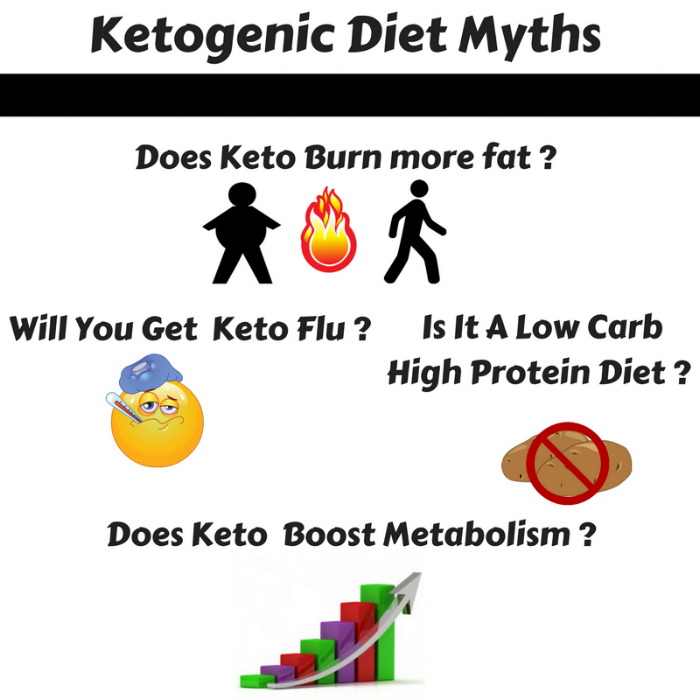Myths About the Keto Diet That You Should Stop Believing

here’s no stopping the keto diet, especially now that New Year’s resolution season is in full swing. If you’ve decided to commit to the high-fat, very-low-carb plan after hearing about its touted perks — a sharper memory, less brain fog, more energy, stabilized blood sugar, or most common, quick weight loss — there are a few things you need to know first.

Myth 1: Your Body Goes Into Ketoacidosis
Reality: It’s ketosis that causes the fat burn in keto.
When you go on a keto diet, you enter ketosis, a metabolic state where your body uses fat for fuel (rather than glucose, its preferred energy source). During this process, the body breaks down fat and converts it into ketone bodies. This is not the same thing as diabetic ketoacidosis, a potentially life-threatening complication of diabetes that happens when your body does not get enough insulin and ketone levels are simultaneously high, according to the Mayo Clinic.
Myth 2: You Can Go on and off Keto and Still Keep the Weight Off
Reality: Seesawing on keto will just lead you to gain all the weight back.
Keto has become such a fad that people don’t understand what they’re getting into and jump into the diet, says Audrey Fleck, RDN, an integrative and functional dietitian nutritionist and certified diabetes educator in Perkasie, Pennsylvania. Because of that, people often follow the keto diet one day and then eat carbs the next, she says. But you’re not going to reap the potential benefits of sustained ketosis this way.

Myth 3: Everyone Has the Same Carb Needs
Reality: How many carbs you should eat really depends on your personal health.
When you start a very-low-carb diet like keto, you may not realize how low in carbs it is. Followers typically consume 20 to 50 grams (g) of carbohydrates a day, often beginning on the lower end of that spectrum to help the body enter ketosis. Nonetheless, depending on factors (like physical activity), you may be able to go higher, says Fleck. She recommends teaming up with a dietitian who can calculate your nutritional needs. What’s more, sometimes it’s not even necessary to go keto, she says. “Some people have genetic issues with using fat for energy, making the diet even more difficult or ineffective for them,” says Fleck.
If you’re looking for an easier way to be on keto then try a custom keto diet plan which includes:
- An eight-week meal plan created based on the expertise of certified nutritionists, personal trainers, and chefs.
- Meals that have calorie and macronutrient content tailored to their specific situation and goals.
- A nutrition plan with food variety to ensure they will get a wide range of nutrients and boost the likelihood of sticking to their diet.
- Meals that are based on personal food preferences to make their diet enjoyable and help them stay on track with their plan.
Myth 4: Keto Gives You Permission to Eat as Much Bacon and Butter as You Want
Reality: Keto calls for prioritizing unsaturated fat in your diet.
Yes, keto is a diet rich in fats. But that doesn’t mean you’re supposed to fry up a pound of bacon in the morning. “The ketogenic diet doesn’t give you the green light to eat all types of fats,” says dietitian Jill Keene, RDN, in White Plains, New York. The healthiest way to load up on fats is to limit saturated fats, like bacon and sausage, and to fill your diet with heart-healthy unsaturated fats, like avocados, olive oil, and flaxseed, along with nuts in moderation.
Myth 5: Because Veggies and Fruits Can Be High in Carbs, You Can’t Eat Them on Keto
Reality: You need to eat produce to avoid constipation, a nasty keto side effect.
Fruits and veggies are sources of carbohydrates. (The only things that will be carb-free are oils, butter, and meat.) Still, that doesn’t mean you should avoid produce. In fact, these whole, unprocessed foods are important sources of vitamins, antioxidants, and fiber — the latter of which is critical for avoiding constipation, a common keto side effect. Keene recommends nonstarchy veggies, like zucchini, cauliflower, cucumbers, peppers, and broccoli, plus small amounts of lower-carb fruits, like berries — think strawberries, raspberries, and blueberries. That said, there are still some healthy foods that are not allowed on the keto diet, so you’ll want to consult the common keto diet food list first.

